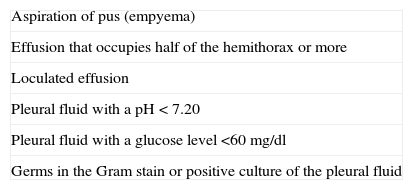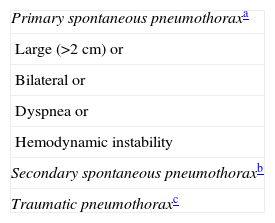A parapneumonic effusion should be drained if it is large (≥1/2 of the hemithorax), loculated, frank pus is obtained, if the fluid is non-purulent fluid but has a low pH (<7.20) or if the culture is positive. Instillation of fibrinolytics and DNase thorough the chest catheter in locutated effusions and empyemas is currently recommended. Management of spontaneous pneumothorax is fundamentally influenced by the patient's symptoms. Insertion of a chest catheter is mandatory if there is significant dyspnea, hemodynamic instability or large pneumothoraces (≥2cm). Pleural ultrasonography confirms the presence of air or fluid in the pleural space and serves to guide any pleural procedure (e.g., thoracentesis, chest tubes). The use of small-bore 12F catheters inserted via the percutaneous Seldinger technique under ultrasonography guidance is a safe and effective procedure in complicated parapneumonic effusions/empyema and most pneumothoraces.
Un derrame paraneumónico requiere drenaje pleural cuando es grande (≥1/2 del hemitórax) o está loculado, se obtiene pus (empiema) o bien el líquido no es purulento pero tiene un pH <7,20 o el cultivo es positivo. Se recomienda la administración de fibrinolíticos y DNasa a través del catéter torácico en los derrames loculados y empiemas. El manejo del neumotórax espontáneo está influenciado fundamentalmente por la sintomatología del paciente. Si hay disnea significativa, inestabilidad hemodinámica o el neumotórax es grande (≥2cm) se debe insertar un catéter pleural de forma inmediata. La ecografía pleural confirma la presencia de líquido o aire en el espacio pleural y sirve para dirigir cualquier procedimiento pleural (toracocentesis o tubo de drenaje). Los tubos torácicos de pequeño calibre colocados mediante técnica Seldinger y bajo guía ecográfica son seguros y eficaces en el tratamiento de los derrames paraneumónicos complicados/empiemas y la mayor parte de neumotórax.
Article
Diríjase desde aquí a la web de la >>>FESEMI<<< e inicie sesión mediante el formulario que se encuentra en la barra superior, pulsando sobre el candado.

Una vez autentificado, en la misma web de FESEMI, en el menú superior, elija la opción deseada.

>>>FESEMI<<<













